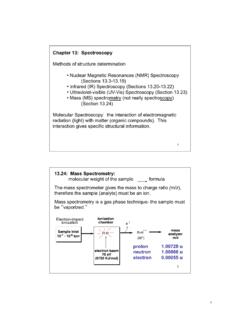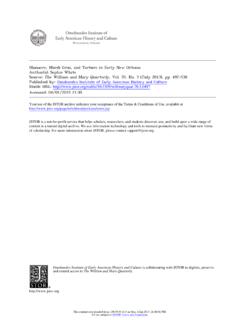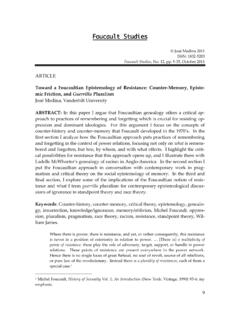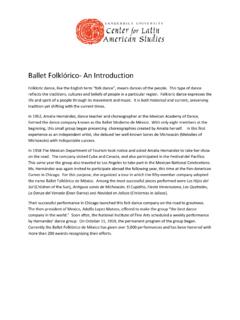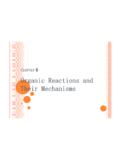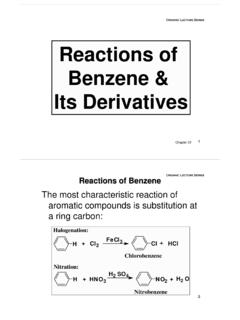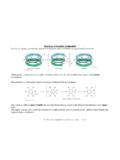Transcription of Chapter 15: Benzene and Aromaticity
1 11 Chapter 15: Benzene and AromaticityHHHHHHHHHHHHC6H62 -bonding MO -antibonding MOMO s of a C=C -bond * +235 KJ/mol-235 KJ/molfrom Chapter 123 -molecular orbitals of butadiene0 Nodes 3 bonding interactions 0 antibonding interactionsBONDING MO1 Nodes 2 bonding interactions 1 antibonding interactions BONDING MO2 Nodes 1 bonding interactions 2 antibonding interactions ANTIBONDING MO3 Nodes 0 bonding interactions 3 antibonding interactions ANTIBONDING MO 2 is the Highest Occupied Molecular Orbital (HOMO) 3 is the Lowest Unoccupied Molecular Orbital (LUMO)4 1 of Butadiene (no nodes, bonding MO)The four -electrons in 1 are delocalizedover the four p-orbitals _+ _+ H3 CCH3H2 CCH2H2 CCHCH3H2 CCHCHCH2H2 CCHCHCH2 Table (p.)
2 528): Bond lengths in pm154 133 149 148 134 Bonding Interaction35!1!2!3!4!5!6 -molecular orbitals of hexatrienefive nodesfour nodesthree nodestwo nodesone nodezero nodes6 AO s = 6 MO ssix p-orbitals6 Conjugation: series of overlapping p-orbitalsAromaticity: cyclic conjugated organic compounds such as Benzene , that exhibit special stability due to resonancedelocalization of : Naming aromatic compounds: (arenes)large number on non-systematic names (Table )CH3 OHOCH3NH2benzene toluene phenol anisole anilin e styreneGenerally, mono-substituted benzenes are named in a similar manner as hydrocarbons with - Benzene as the parentnameBrbromobenzeneCH2CH3ethylbenze ne(1-methylethyl) Benzene (isopropylbenzen e)NO2nitrobenzene8 When the Benzene ring is a substituent of a parent chain, referred to as a phenyl group.
3 The Benzene ring is is regarded as a substituent when the parent chain has greater than six carbons. The Benzene ring is the parent when the longest alkyl chain substituent is six carbons or lessA phenyl substituent (C6H5-) is often abbreviates as Ph-A C6H5-CH2- susbtitutent is often referred to as a benzylgroup (Bn-)ParentchainBenzylgroupParentchainPh enylgroup2-methyl-7-phenyloctane(1-methy lbutyl)benzene59 Disubstituted Benzene : relative position of the substitutents1,2-disubstituted: ortho (o-)1,3-disubstituted:meta (m-)1,4-disubstituted: para (p-)YXYXYXNote: ortho, meta, and para are not used in systematic nomenclaureCH32-chlorotolueneortho-chlor otolueneo-chlorotolueneCH3CH31,3-dimethy lbenzenemeta-xylenem-xyleneCO2 HCl4-chlorobenzoic acidpara-chlorobenzoic acidp-chlorobenzoic acidCl10 Benzenes with two or more substituents:Choose numbers to get lowest possible valuesList substituents alphabetically with hyphenated numbersCommon names, such as toluene can serve as root name (as in TNT) : Structure and Stability of BenzeneFormula.
4 C6H6, four degrees of unsaturation (section ) three double bonds + one ringThe -bonds of Benzene are resistant to the normal reactions of alkenes and alkynesBrBrClCHOCHOBr2 HClO3No ReactionBenzene s cyclic conjugated structure gives it special stability12 Benzene undergoes electrophilic substitution reactions ( Chapter 16) rather than electrophilic addition BrBr+BrBrBrHBr+Fecatalystelectrophilic additionelectrophilicsubstitutionStabili ty of Benzene : Heats of Hydrogenations+ H2+ 2 H2+ 3 H2+ 118 KJ/mol+ 230 KJ/mol calc'd value= 336 KJ/mol 6 KJ/mol added stability+ 206 KJ/mol calc'd value= 354 KJ/mol 148 KJ/mol added stability713 Structure of Benzene :Kekule Benzene .
5 Two forms are in rapid equilibrium154 pm134 pm All bonds are ~139 pm (intermediate between C-C and C=C) Electron density is distributed evenly between the six carbons Structure is planar, hexagonal C C C bond angles are 120 Each carbon is sp2 and has a p orbital perpendicular to the plane of the six-membered ring14 Arrows in organic chemistryReaction arrowEquilibrium arrowResonance arrowDouble-headed arrowSingle-headed arrowMechanism arrows815 Drawing and Interpreting Resonance Forms( Chapter and ) one resonance forms accurately depicts the structure of the molecule. The real structure is a composite or hybrid of all resonance forms differ only by the placement of - or non-bonding electrons.
6 Neither the position or hybridization of the atoms forms are not necessarily equivalent. While all resonance forms contributeto the actual structure (resonance hybrid), some forms may contribute resonance forms must be proper Lewis actual resonance hybrid is more stable than any single resonance general, the greater the number of resonance forms, the more stable the resonance : Molecular orbitals of benzenes: (figure )!1!2!3!4!5!6six p-orbitals 1: zero nodes 2 and 3: one node 4 and 5: two nodes 6: three nodeDegenerate orbitals: orbitalsthat have the same energy BondingAnti-bondingsix AO s = six MO & : Aromaticity and the H ckel 4n + 2 RuleCyclic conjugated molecules: not all cyclic conjugated systemsare aromatic (no special stability)cyclobutadiene Benzene cyclooctatetraene 4 !
7 -electrons 6 !-electrons 8 !-electronsCyclobutadiene: highly reactivetwo different C-C bondsCyclooctatetraene: reactivity similar to normal C=CExists in a boat-like conformation:little overlap betweendouble bondsDiels-Alder-78 C+18 aromatic :CyclicConjugated: alternating single and double bonds Flat: maximum overlap between conjugated -bondsMust contain 4n+2 -electrons, where n is an integer(H ckel s rule)Anti- aromatic :cyclic, conjugated, flat molecules that contain4n -electrons (where n is an integer). Destabilized (highly reactive) relative to the corresponding open-chain conjugated system1019 Frost Circles: relative energies of the molecular orbitals of cyclic, conjugated systemsInscribe the cyclic, conjugated molecule into a circle so that a vertex is at the bottom.
8 The relative energies of the MO s are where the ring atoms intersect the circlebenzene:Benzene6 !-electronsnon-bonding levelFor aromatic compounds, such as Benzene ,the bonding MO's will be MO'santi-bonding MO'scyclobutadiene:Cyclobutadiene4 !-electronsnon-bonding MO'sFor anti- aromatic compounds, such as cyclobutadiene, there will be unpaired electrons in bonding, non-bonding or antibonding MO' MOanti-bonding : aromatic ions+ AgBF4 HHHHHClHBF4 + AgClClHHHHH+ AgBF4 HHHHHBF4 + AgCl4n+2=2n=0aromatic4n=4n=1anti-aromati ccyclopropenyl cation2 !-electronsHHH"1"2"3 HHHHH cyclopentadienyl cation4 !-electrons"1"2"3"4"511214n+2=6n=1aromat ic4n=4n=1anti- aromatic + B:HHHHHHH+ B:Hcyclopropenyl anion4 !
9 -electrons"1"2"3 HHHHHH+ B:HHHHH + B:Hcyclopentadienyl anion6 !-electrons"1"2"3"4"5pKa ~ 1522 BrH+Br-K02 -2K+6 -electron10 : aromatic HeterocyclesHeterocycle: any cyclic compound that contains ring atom(s) other than carbon (N, O, S, P)Cyclic compounds that contain only carbon are called carbocycles Heterocyclic aromatic compounds are numerous, common and a very important class of organic compoundsNomenclature for heterocyclic compounds is specializedNNHNHNO pyridine pyrrole imidazole furanSSNON thiophene thiazole oxazole24 Pyridine -electron structure resembles Benzene (6 -electrons)The nitrogen lone pair electrons are not part of the aromatic system (perpendicular orbital)6 -electronsN1325 Pyrrole.
10 6 -electron system similar to that of cyclopentadienyl anionFour sp2-hybridized carbons with 4 p orbitals perpendicular to the ring and 4 p electronslone pair of electrons in an sp2 orbital; part of the aromatic sextetPyrrole is much less basic than pyridine. Why? : Polycyclic aromatic hydrocarbons (PAH s): Benzene naphthalene anthracene phenanthrenepyrene benzo[a]pyrene coronene triphenyleneazulene indene floureneNHNH carbazole indole quinoline quinoxalineNNNP olycyclic heterocycles1427 Polycyclic aromatic hydrocarbonsAromatic compounds can have rings that share a set of carbon atoms (fused rings)Compounds from fused Benzene or aromatic heterocyclic rings are themselves aromaticNaphthalene: 4n+2=10, n=2 note.



